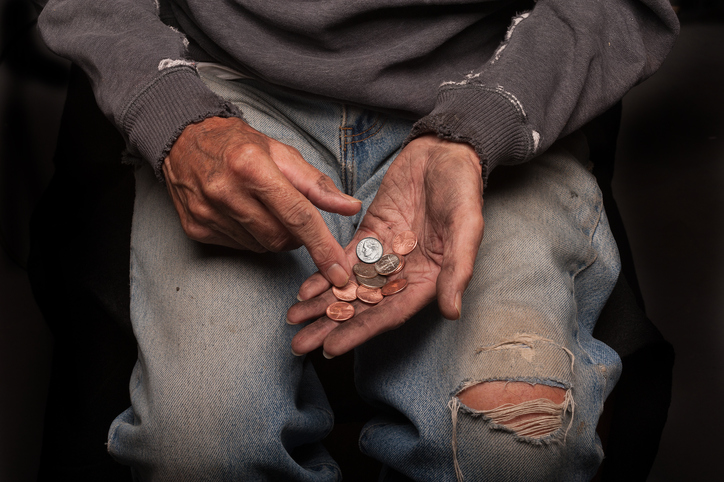Part 2
Causes of Poverty
What are the root causes of poverty? This is a complex question with varied answers. Most agree that labor market forces are in part responsible. In most poor families, the parent or parents work—but often jobs with low wages. There are often many poor workers available for a single job, often driving the employer to take advantage of the worker. Inadequate education is another driver of poverty. Those without a high school degree or with only high school education can only get low-skill positions that pay poorly. Income over a lifetime is significantly less for those with only a high school degree or less. Family structure seems to appear to be associated strongly with poverty. In single parent households, poverty is four times greater in white and black single parent families, and two times greater in Hispanic single parent families. Often, in single parent families, the mother is the caretaker for the family and left to financially support herself and her kids, often without any help from the father. Since there is one parent, there is only one income. If the parent is the mother, she often faces gender inequality in the workforce often with lower wages. Racial disparities also contribute with blacks and Hispanics making less money than white individuals. Often blacks and Hispanics work lower skill jobs and have less education. It is difficult to measure the extent racism independently plays a role. Some sociologists believe that the effects of racism may due to lower wages paid to blacks and Hispanics decades ago and those effects persisting. Lack of affordable housing has also led the poor to remain poor. Landlords often take advantage of those desperate poor families by charging exorbitant rents (often taking most of their paycheck), not making repairs, reporting tenants to child protective services for any tenant infraction, and often eviction. These tenants are then left with an eviction on their record, and desperate to find any sort of housing—often dilapidated, in disrepair. Medical expenses have plagued Americans due to rising cost of healthcare and the continued shrinking coverage health insurance affords. Large out of pocket medical expenses are the norm and most Americans (both poor and middle class) have to drain bank accounts or borrow to pay off medical costs. And for those without insurance, they are an accident away from financial ruin. Substance abuse affects about 20-50% of the homeless with alcohol being the most common substance abused. It is unclear if substance abuse is a cause or an effect of homelessness—most likely that it is both. Being homeless is very stressful and often alcohol or drugs are the only way to escape the problems of living on the streets. Conversely, many fall victim to substance abuse and are affected by the cost of buying drugs and alcohol. The cost of substance abuse can also include missed work, diminished job efficiency, or job termination—often significantly affecting their income. Additionally, substance abuse can run up medical expenses from illness or accidents and legal expenses from driving under the influence. This drives families into poverty or homelessness.
Persistence of Poverty
Given the fact that the poverty rate has remained between 10% and 15%, what are the causes of this persistence of poverty. Certainly, the US is behind other developed nations in safety net and welfare programs, but the data shows that over time these programs have spent more and more without significantly impacting the poverty rate. What is then responsible? Matthew Desmond, Pulitzer Prize-winning sociologist at Princeton, writes in his book Poverty, by America that exploitation of the poor is most likely the explanation. He explains that there two kinds of exploitation of the poor: 1) labor exploitation, and 2) consumer exploitation.
Labor exploitation is the exploitation of workers by employers in order to maximize profits. Undocumented workers who are paid below minimum wage nor overtime is a clear example as undocumented workers are often desperate to find work because of undocumented status. And because there are so many unemployed undocumented workers, they are often forced to accept whatever wages their employer is willing to pay. Minimum wage has not kept up with the rising cost of living and the US is far behind other developed countries in paying its poorest workers a “living wage.” Additionally, wage stagnation is a direct result of the de-unionization of workers in America. While in other developed countries unions have persisted and allowed workers to continue to negotiate higher wages, the US has allowed corporations to continue to disband organized labor in favor of corporate America and the health of the US economy.
Consumer exploitation is also responsible for the persistence of poverty and perhaps more pernicious as it seeks to take direct advantage of the most vulnerable among us. Consumer exploitation starts with the most basic need: a home. Most poor rent and cannot afford to buy home due to nonexistent savings and poor credit. And when the poor rent, they are often subject to exorbitant rents that have steadily risen faster than inflation. Landlords often rent dilapidated apartments without making repairs when needed. They charge as much as they can, and because their mortgages and operating costs are lower, their profits are much greater than landlords who have apartments in affluent neighborhoods. Poor residents because of their poor credit and eviction histories are limited to renting apartments in poor neighborhoods even though the rents in affluent neighborhoods are only fractionally greater.
Banking deregulation has led to another avenue of exploitation of the poor. Because most banks require minimum balances, the poor often subject to overdrawing on their accounts. This leads to overdraft fees which annually cost Americans 11 billion dollars. As a result, many poor Americans don’t open bank accounts and use check cashing services which generally charge from 1 to 10% of the total of their paycheck. That means someone who is paid for 80 hours of work, looses 8 hours of work to just get his or her money. Yearly, Americans spend 1.6 billion dollars to cash checks.
Poverty also can result in a poor or nonexistent credit history. Most poor don’t have the ability to pay their bills in a timely manner or have a credit card, an auto loan, or mortgage. This can result in difficulty in finding employment if an employer relies on a credit check for the hiring process. So, how do the poor borrow money when their car breaks down. There is the practice of payday lending.
What is a payday loan? This is usually a short term (2 to 4 weeks) loan of up to $500 which is paid back in full with fees by the next paycheck. The usual requirements include identification, proof of income, and a bank account the lender has access to in order to deposit the loan and to later deduct fees and the loan amount. This can result in borrower triggering overdraft fees if he or she does not have the funds to cover the withdrawal. The fees for a payday loan can range between $10 to $30 for every $100 borrowed. The most common fee is $15 for every $100 and with a loan term of 2 weeks calculates to an APR of 390%. In comparison, most credit card companies charge an APR of 18 to 30%.
In most situations, the poor often can’t payback their payday loan within two weeks and often need to ask for extensions. This extension usually given for an additional fee. If the extension incurs an additional $15 for every $100 for another 2 weeks, these costs can snowball and with the fees being greater than the original loan amount. According to Desmond, “the average borrower stays indebted for five months, paying $520 in fees to borrow $375.” The payday lending business charges up to 8.2 billion dollars in fees per year.
Ashna Dagam

